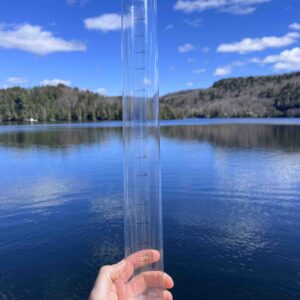Turbidity (NTU)
What is turbidity?
Water turbidity measures how cloudy a sample of water is due to suspended particles like sediment and plankton. Turbidity can be an indicator of the health of stream processes.

Why is turbidity important?
Various factors can contribute to high turbidity in water. Suspended particles may originate naturally, such as from algae and eroding streambanks, or they can result from human activities like construction, mining, and agriculture, which wash particles into water bodies during rainstorms. In lakes and rivers, this can diminish light penetration to the bottom, impeding the growth of submerged plants and impacting aquatic species dependent on them for nutrients. High turbidity levels can also hamper fish’s ability to absorb dissolved oxygen through their gills. Additionally, turbid waters often experience temperature increases, reducing available oxygen and affecting fish development.
What about JTU?
An alternative unit for turbidity is JTU. The Jackson Turbidity Unit (JTU) is a historical measurement done with the Jackson Candle Turbidimeter. To use this measurement tool, the tester pours water into a tube positioned over an open flame until the flame is no longer visible! This is not a common method these days — modern meters can measure this value with no flames involved. Read more about Jackson Candle Turbidimeters.
What does a turbidity measurement mean?
Baseline testing is important as each body of water will have unique factors contributing to turbidity and conditions can change! Recording in the same place over time will give you a more accurate picture of what is normal for your body of water.
A common measure of turbidity is the Nephelometric Turbidity Unit (NTU), typically measured using a nephelometer, though other field and lab methods exist. A higher NTU value indicates that the water is cloudier and light cannot penetrate as easily. Conversely, lower NTU measurements indicate the water is clear with fewer suspended particles.
- 1 NTU: Common measurement for tap water.
- 1 NTU: Common regulatory limit for drinking water quality.
Turbidity or Secchi depth? Which measurement should I use?
Turbidity and Secchi depth are both measures of water clarity, however one may be more suitable than the other depending on the conditions of the water you are testing.
When to use turbidity:
- water bodies that appear cloudy or opaque (>20 NTUs)
- shallow and/or fast moving water bodies where a Secchi disk would be ineffective
When to use Secchi depth:
- water bodies with low to moderate levels of turbidity when you can see the bottom (<40 NTUs)
- slower-moving water bodies, like lakes, ponds and large rivers
Water Rangers testing protocol
Water Rangers uses a specialized tube to measure turbidity. The 45cm tube includes a small Secchi disk and a measurement scale in NTUs.



- Fill your transparency tube completely with water, being careful not to disturb the sediment too much at your location, as it may affect the accuracy of your measurement.
- Peer down the top of the tube (do not wear sunglasses and shade your view from bright lights). If you can clearly see the black-and-white disk, record 14 NTU as the turbidity measure.
- If you can’t see the bottom disk, pour out water a bit at a time, continuing to check down the tube’s top until you can see the disk.
- Once you find the ‘sweet spot’ where the Secchi disk lines are distinguishable, check the side of the tube for the measurement in NTU. The higher the measurement, the less clear the water is.
- Pour out the remaining water and rinse your tube in clean water when you return home.
Get a Turbidity Tube here:
Contributing to the community!
Water Rangers is citizen-scientist led. So, if you have any questions, ideas, or notice any errors, please tell us!

